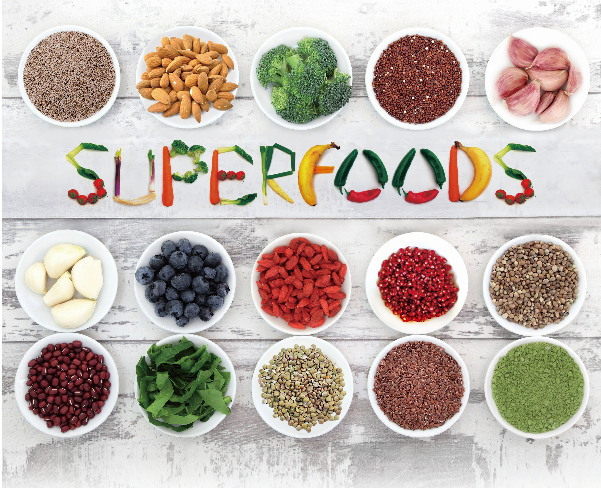For Lee Kyung-ja, a 63-year-old housewife who has lived in Latin America for more than 40 years, the biggest concern ahead of her planned return to Korea was food.
Having lived in Bolivia, the home of a slew of so-called superfoods like quinoa and lentils, she had no idea how to maintain her decade-old eating habits. But her concerns vanished during a recent visit to Seoul.
“I was pleasantly surprised that almost all food items from Latin America are available at local supermarkets. There were even some I was unfamiliar with,” she said. “From this experience, I could gauge the healthy-food fever in Korea.”

Superfoods have become a permanent fixture in the shopping bags of health-conscious Koreans, who are known for catching on fast to new global trends.
The term “superfood” first appeared in the 2007 book “SuperFoods Rx,” written by renowned American ophthalmologist Steven Pratt. The author outlined 14 functional foods including blueberries, tomatoes and wild salmon that should be eaten in combination with other foods for maximum health benefits.
Now “superfood” no longer refers to specific food items. The word is considered an effective marketing tool to lure consumers willing to spend big on healthy eating.
Mainstream retailers have dedicated their coveted floor space to superfoods or dietary supplements, while juice bars, equipped with fancy recipes, have cropped up on every corner in Seoul’s posh districts.
According to Emart, the nation’s No. 1 supermarket chain, sales of blueberries, which help lower the risk of cardiovascular disease, surged 186.4 percent this month from a year ago. Other popular superfoods, including tomatoes, almonds, garlic and yogurt also enjoyed a sales boom.
“Grains from abroad such as lentils and quinoa are also popular as they taste good when cooked together with steamed rice or other Korean foods,” said Ryu Hae-ryung, an Emart merchandiser.
More novel items like acai berries ― which strengthen the immune system ― and chia seeds ― which are rich in omega-3 fatty acids ― are also becoming popular.
With the popularity of overseas foods, some local products such as homegrown oats, brown rice and mackerel, have also come under the spotlight.
Traditional Korean restaurants are going upscale with new menu items that feature Korean superfoods, while lavish Italian or French restaurants are putting superfoods into their signature items to attract high-end diners.
This week’s Weekender takes a closer look at the superfoods fad and explores the spread of the trend in the food and retail sectors.
By Lee Ji-yoon (jylee@heraldcorp.com)
Having lived in Bolivia, the home of a slew of so-called superfoods like quinoa and lentils, she had no idea how to maintain her decade-old eating habits. But her concerns vanished during a recent visit to Seoul.
“I was pleasantly surprised that almost all food items from Latin America are available at local supermarkets. There were even some I was unfamiliar with,” she said. “From this experience, I could gauge the healthy-food fever in Korea.”

Superfoods have become a permanent fixture in the shopping bags of health-conscious Koreans, who are known for catching on fast to new global trends.
The term “superfood” first appeared in the 2007 book “SuperFoods Rx,” written by renowned American ophthalmologist Steven Pratt. The author outlined 14 functional foods including blueberries, tomatoes and wild salmon that should be eaten in combination with other foods for maximum health benefits.
Now “superfood” no longer refers to specific food items. The word is considered an effective marketing tool to lure consumers willing to spend big on healthy eating.
Mainstream retailers have dedicated their coveted floor space to superfoods or dietary supplements, while juice bars, equipped with fancy recipes, have cropped up on every corner in Seoul’s posh districts.
According to Emart, the nation’s No. 1 supermarket chain, sales of blueberries, which help lower the risk of cardiovascular disease, surged 186.4 percent this month from a year ago. Other popular superfoods, including tomatoes, almonds, garlic and yogurt also enjoyed a sales boom.
“Grains from abroad such as lentils and quinoa are also popular as they taste good when cooked together with steamed rice or other Korean foods,” said Ryu Hae-ryung, an Emart merchandiser.
More novel items like acai berries ― which strengthen the immune system ― and chia seeds ― which are rich in omega-3 fatty acids ― are also becoming popular.
With the popularity of overseas foods, some local products such as homegrown oats, brown rice and mackerel, have also come under the spotlight.
Traditional Korean restaurants are going upscale with new menu items that feature Korean superfoods, while lavish Italian or French restaurants are putting superfoods into their signature items to attract high-end diners.
This week’s Weekender takes a closer look at the superfoods fad and explores the spread of the trend in the food and retail sectors.
By Lee Ji-yoon (jylee@heraldcorp.com)





No comments:
Post a Comment